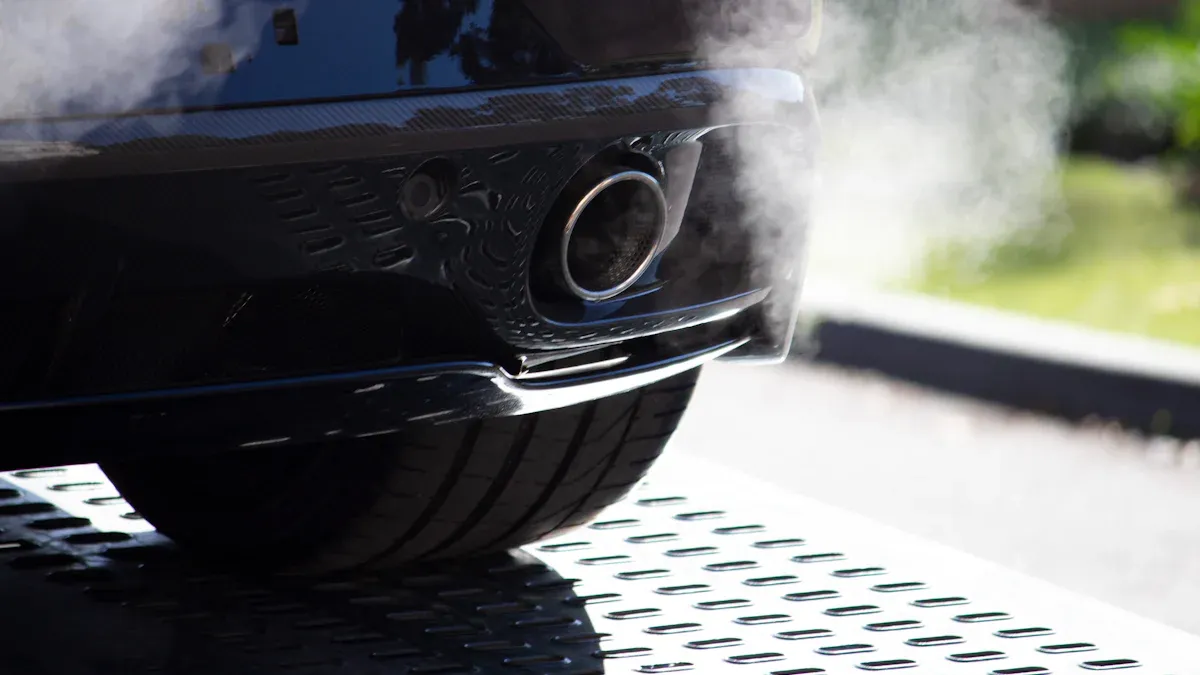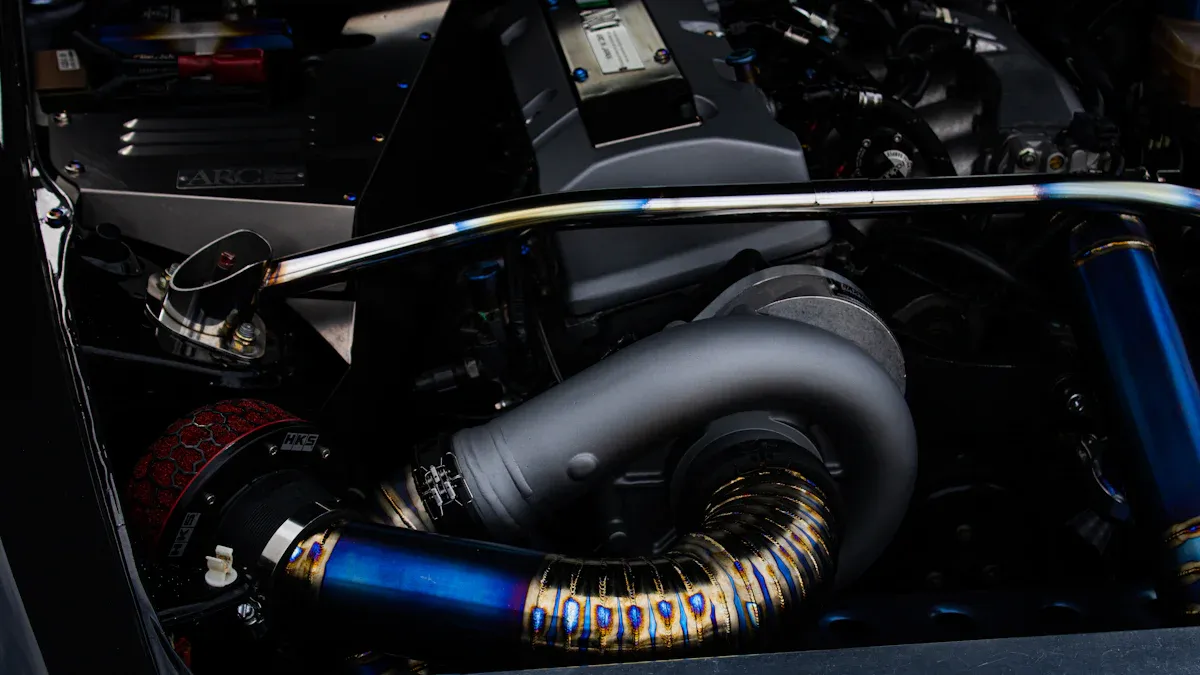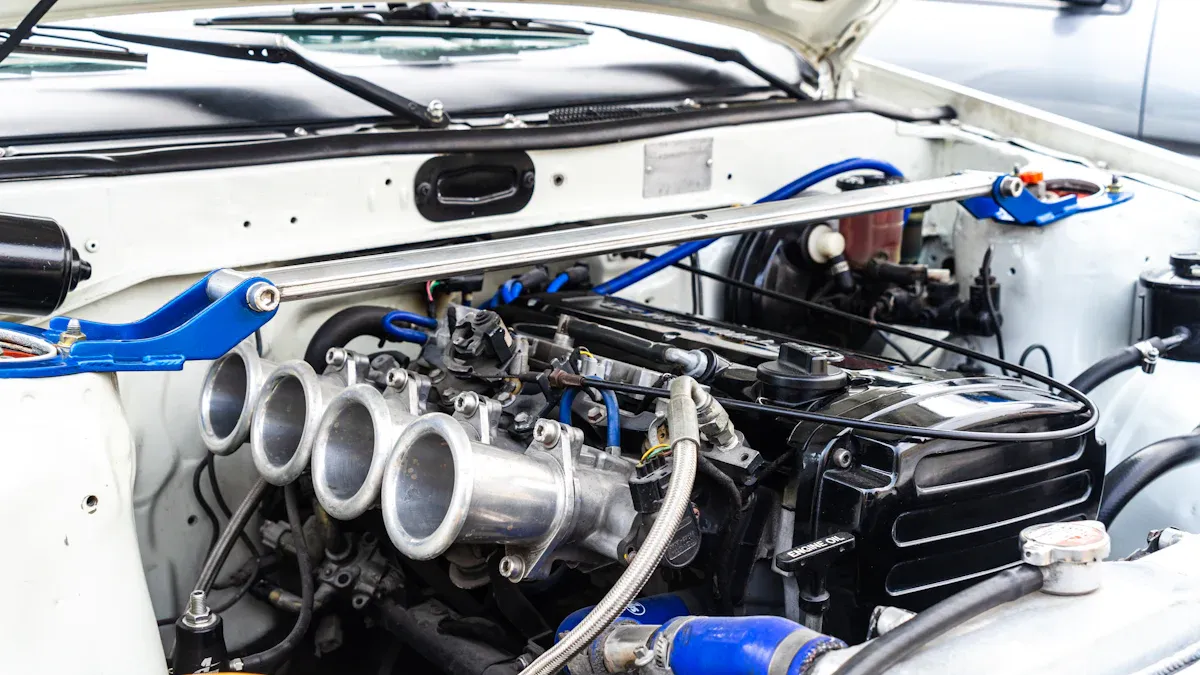
The exhaust manifold in a car engine plays a crucial role, acting as a traffic controller for exhaust gases by collecting them from the engine’s cylinders and directing them to the exhaust system. This component, along with the inlet and exhaust manifold, is designed to withstand extreme heat and pressure, ensuring a smooth flow of gases. Additionally, modern systems often incorporate catalytic converters to reduce harmful emissions, enhancing engine efficiency. Regular maintenance, such as a harmonic balancer replacement, is essential to ensure the engine harmonic balancer and other components work seamlessly, contributing to a cleaner and more efficient engine.
The Function of an Exhaust Manifold In Car Engine

Collecting Exhaust Gases
The exhaust manifold in a car engine serves as the first stop for exhaust gases after combustion. It collects these gases directly from the engine’s cylinders and channels them into the exhaust system. This process is vital for maintaining engine efficiency and preventing harmful emissions from escaping into the environment.
- Exhaust manifolds are designed to be airtight, ensuring minimal heat loss and helping maintain optimal engine temperature.
- Smaller engines typically use a single manifold, while larger engines, such as those with a ‘V’ configuration, rely on two manifolds—one for each bank of cylinders.
By efficiently gathering exhaust gases, the manifold ensures that the engine operates smoothly and avoids overheating. Its airtight construction also plays a role in reducing noise levels, making the driving experience more pleasant.
Tip: Regular inspections of the exhaust manifold can help identify cracks or leaks early, preventing costly repairs down the line.
Directing Gases to the Exhaust System
Once the exhaust manifold collects the gases, its next job is to direct them into the exhaust system. This step is crucial for maintaining proper exhaust flow and preventing engine damage. The manifold’s design influences how efficiently gases move through the system, impacting overall engine performance.
- The manifold channels exhaust gases into the exhaust pipe, ensuring a smooth transition.
- It prevents cold air from entering the combustion chamber, a phenomenon known as “reversion,” which can cause engine damage.
- Computational Fluid Dynamics (CFD) simulations help engineers optimize manifold designs for better scavenging and reduced turbo lag.
CFD analysis also addresses thermal management, ensuring the manifold can withstand extreme temperatures without compromising performance. By directing gases effectively, the exhaust manifold contributes to improved fuel efficiency and compliance with emission standards.
Preventing Reversion of Exhaust Gases
Reversion occurs when exhaust gases flow backward into the engine, allowing cold air to enter the combustion chamber. This can disrupt the combustion process, reduce engine efficiency, and even cause long-term damage. The exhaust manifold plays a key role in preventing this issue.
Its airtight construction and precise design ensure that gases flow in one direction—out of the engine and into the exhaust system. By maintaining consistent pressure and flow, the manifold minimizes the risk of reversion. This not only protects the engine but also enhances its performance by improving scavenging, the process of clearing exhaust gases from the cylinders to make room for fresh air and fuel.
Note: A damaged or poorly designed manifold can lead to reversion, so timely repairs and replacements are essential for optimal engine health.
Importance of the Exhaust Manifold in Engine Performance
Ensuring Proper Exhaust Flow
The exhaust manifold plays a key role in maintaining smooth exhaust flow. It ensures that gases exit the engine efficiently, preventing blockages or turbulence that could disrupt performance. A well-designed manifold improves the flow of exhaust gases, which directly impacts the engine’s power and efficiency.
To better understand this, here’s a breakdown of how proper exhaust flow affects performance:
| Performance Metric | Description |
|---|---|
| Thermal Management | Insulated exhaust manifolds retain heat, improving efficiency of components like catalyst converters. |
| Engine Performance Enhancement | Manifold design affects power output, torque, and fuel efficiency through optimized geometries. |
| Optimized Flow Designs | Innovations in manifold design reduce turbulence and pressure drops, enhancing overall engine performance. |
By optimizing the exhaust flow, the manifold ensures that the engine operates at its best. This not only boosts performance but also helps in reducing harmful emissions.
Tip: Regular inspections can help identify issues like blockages or cracks in the manifold, ensuring proper exhaust flow is maintained.
Reducing Backpressure
Backpressure occurs when exhaust gases face resistance while exiting the engine. This resistance can reduce engine efficiency and power. The exhaust manifold is designed to minimize backpressure, allowing gases to flow freely through the exhaust system.
Studies have shown that improving manifold design can significantly reduce backpressure. For example:
| Study Title | Findings |
|---|---|
| Experimental Investigation and CFD Analysis of a Multi-Cylinder Four Stroke SI Engine Exhaust Manifold for Optimal Geometry to Reduce Backpressure and to Improve Fuel Efficiency | Optimized manifold designs reduce backpressure, improving engine performance and fuel efficiency. |
| CFD Analysis of Exhaust Manifold of Multi-Cylinder Petrol Engine for Optimal Geometry to Reduce Back Pressure | Design modifications lower backpressure and enhance volumetric efficiency. |
| Design and Analysis of a Multi-Cylinder Four Stroke SI Engine Exhaust Manifold Using CFD Technique | Improved manifold designs reduce backpressure, leading to better engine performance. |
By reducing backpressure, the exhaust manifold ensures that the engine doesn’t have to work harder than necessary. This not only improves performance but also extends the engine’s lifespan.
Enhancing Fuel Efficiency and Power
A well-functioning exhaust manifold contributes to better fuel efficiency and power. By ensuring proper exhaust flow and reducing backpressure, the manifold allows the engine to burn fuel more effectively. This means the engine can produce more power while using less fuel.
When exhaust gases exit the engine smoothly, the combustion process becomes more efficient. This leads to:
- Improved fuel economy, saving drivers money at the pump.
- Increased power output, making the car more responsive and enjoyable to drive.
The exhaust manifold in car engine systems is a critical component for achieving this balance. Its design and condition directly affect how efficiently the engine operates.
Note: Replacing a damaged manifold with a high-quality part can significantly improve both fuel efficiency and power.
Materials Used in Exhaust Manifolds
Cast Iron: Strength and Heat Resistance
Cast iron is one of the most common materials used for exhaust manifolds. Its durability and ability to handle high temperatures make it a reliable choice for many vehicles. This material is particularly effective at withstanding the intense heat generated by the engine, which helps prevent warping or cracking over time.
One of the key advantages of cast iron is its uniform thickness. Unlike tubular designs, it doesn’t rely on welded joints, which can weaken under stress. This makes cast iron manifolds ideal for vehicles that tow heavy loads or are used for daily driving. However, they tend to be heavier, which can slightly impact overall vehicle weight.
Fun Fact: Grey cast iron, a specific type of cast iron, is widely used because of its excellent thermal properties and cost-effectiveness.
Stainless Steel: Lightweight and Durable
Stainless steel exhaust manifolds are known for their lightweight design and superior heat resistance. They distribute heat more evenly than cast iron, which improves engine performance and reduces the risk of hot spots. This material is also resistant to corrosion, making it a great choice for vehicles exposed to harsh weather conditions.
Stainless steel manifolds often feature tubular designs, which enhance airflow and reduce backpressure. These designs are especially popular in high-performance vehicles, where maximizing power output is a priority. While stainless steel may not be as durable as cast iron, its ability to handle extreme temperatures and improve exhaust flow makes it a favorite among car enthusiasts.
Material Impact on Performance
The material of an exhaust manifold significantly affects engine performance. Here’s a quick comparison of how different materials perform:
| Material | Durability | Heat Management | Emissions | Power Output |
|---|---|---|---|---|
| Cast Iron | High | Moderate | Moderate | Moderate |
| Stainless Steel | Moderate | High | Low | High |
| Tubular Designs | Moderate | High | Low | Very High |
Stainless steel manifolds excel in heat management and power output, while cast iron offers unmatched durability. Tubular designs, often made from stainless steel, provide the best performance for high-powered engines.
Tip: When choosing a replacement manifold, consider your vehicle’s needs. For towing or daily driving, cast iron is a solid choice. For performance-focused cars, stainless steel or tubular designs may be better.
Signs and Causes of a Failing Exhaust Manifold

Common Symptoms: Noises, Cracks, and Leaks
A failing exhaust manifold often gives off warning signs that are hard to miss. Drivers may notice unusual noises, like ticking or tapping sounds, especially when starting a cold engine. These sounds usually come from cracks or leaks in the manifold.
Other symptoms include:
- A strong exhaust smell in the engine bay, caused by leaking fumes.
- Sluggish acceleration, as the engine struggles to remove exhaust gases efficiently.
- Poor fuel efficiency due to an incorrect air-fuel ratio from a damaged manifold.
- The Check Engine Light turning on, often triggered by oxygen sensor issues.
Tip: If you notice any of these symptoms, it’s best to have the manifold inspected right away. Ignoring them could lead to bigger problems.
Causes of Failure: Heat and Wear
Exhaust manifolds endure extreme conditions. Over time, constant exposure to high temperatures can cause the material to expand and contract, leading to cracks. This is especially common in cast iron manifolds, which are strong but less flexible.
Wear and tear also play a role. Gaskets that seal the manifold to the engine can degrade, causing leaks. Corrosion from moisture or road salt can weaken the manifold, especially in stainless steel designs.
Did you know? Vehicles used for towing or frequent short trips are more prone to manifold damage due to rapid temperature changes.
Consequences of Neglecting Repairs
Ignoring a failing exhaust manifold can have serious consequences. Cracks and leaks allow harmful gases, like carbon monoxide, to escape into the cabin, posing a health risk. The engine may lose power and efficiency, leading to higher fuel costs.
Over time, the damage can spread to other components, such as the catalytic converter or oxygen sensors. Repairs then become more expensive and time-consuming.
Reminder: Addressing manifold issues early can save money and keep your car running smoothly. Don’t wait until it’s too late!
Maintenance and Replacement of Exhaust Manifolds
Regular Inspections and Repairs
Regular inspections keep exhaust manifolds in good condition and prevent costly repairs. Mechanics recommend checking for cracks, rust, or leaks during routine maintenance. These issues can worsen over time, leading to engine inefficiency or harmful emissions.
- Inspections help spot minor leaks before they become major problems.
- Rust buildup can weaken the manifold, making it prone to cracks.
- In states with emissions testing, a damaged manifold can cause a failed inspection due to incorrect oxygen sensor readings.
Timely repairs save money and ensure the vehicle runs smoothly. Replacing worn-out gaskets or fixing small cracks early prevents damage to other parts, like the catalytic converter.
Tip: Schedule manifold checks during oil changes to catch problems early and avoid surprises.
Choosing Quality Replacement Parts
When replacing an exhaust manifold, choosing high-quality parts is essential. Cheap replacements may seem tempting, but they often wear out faster and can harm engine performance. Cast iron manifolds work well for durability, while stainless steel options improve airflow and resist corrosion.
Drivers should consider their vehicle’s needs. Heavy-duty trucks benefit from cast iron manifolds, while performance cars thrive with stainless steel or tubular designs. Investing in reliable parts ensures long-term savings and better engine efficiency.
Reminder: Always check compatibility with your vehicle model before purchasing replacement parts.
Professional vs. DIY Repairs
Repairing or replacing an exhaust manifold can be tricky. Professionals have the tools and expertise to handle complex installations, ensuring the job is done right. DIY repairs may save money, but they require mechanical knowledge and proper equipment.
For minor fixes, like tightening bolts or replacing gaskets, DIY repairs are manageable. However, larger tasks, such as replacing the entire manifold, are best left to professionals. Incorrect installation can lead to leaks or engine damage.
Note: If unsure, consult a mechanic to avoid costly mistakes.
The exhaust manifold in car engine systems is a vital component for maintaining efficiency and reducing emissions. Regular maintenance keeps it in top shape and prevents expensive repairs. Addressing problems early ensures better fuel economy and protects the environment. Taking care of this part helps drivers enjoy smoother and more reliable performance.
FAQ
What happens if the exhaust manifold cracks?
A cracked exhaust manifold can cause loud noises, reduced engine performance, and harmful gas leaks. It’s important to repair or replace it quickly to avoid further damage.
Can a damaged exhaust manifold affect fuel efficiency?
Yes, it can. A damaged manifold disrupts exhaust flow, forcing the engine to work harder. This reduces fuel efficiency and increases emissions.
How often should the exhaust manifold be inspected?
Experts recommend inspecting the exhaust manifold during routine maintenance or oil changes. Regular checks help catch cracks, leaks, or rust before they become serious problems.
Tip: If you hear unusual engine noises or smell exhaust fumes, get the manifold checked immediately!
Post time: Apr-21-2025



